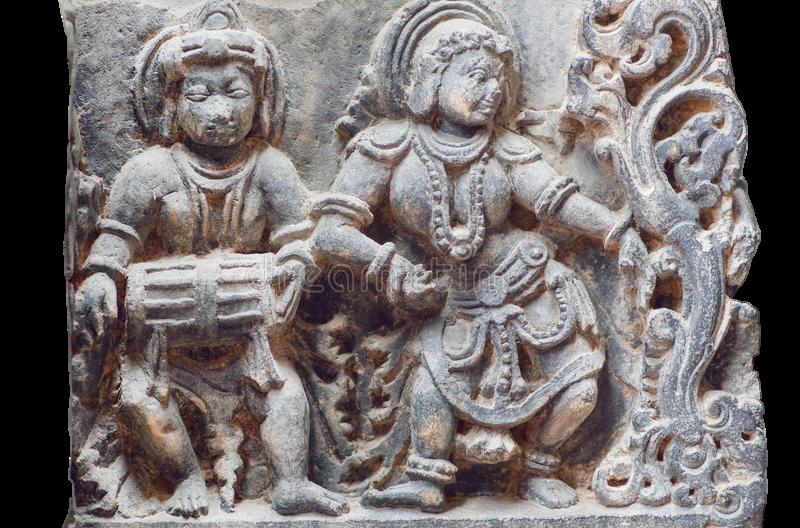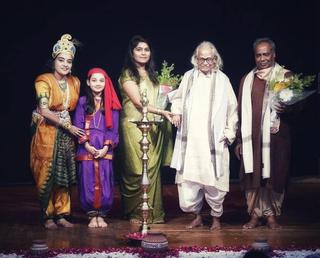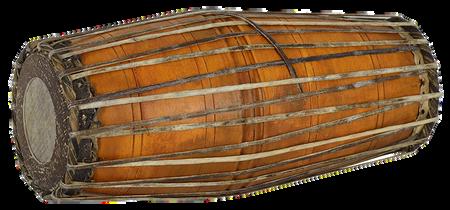
8 minute read
Tagore & theDanceConnection
To understand the philosophy of Rabindranath Tagore, one must understand the connection of Tagore with dance and music. Tagore was just a kid when he witnessed the landlord’s customs of inviting the Bauls and Banjaras to their villas for providing entertainment to the kids and the ladies of the house. Bauls are vaishanav are mainly devotees and they used to wander around. They used to sing devotional song in the love of supreme god and dance in the sufi style accordingly. Tagore’s child heart was much impressed with their free exposition of love for the unseen god. This impression is easily seen in his choreography (presentation) of many songs. The lyrics of his many of songs also present the love and devotion for the unseen, the supreme. He used to call this style of dancing “Bhava-nritya,” where dancer forgets everything and without worrying about her/his looks and the perfection of the dance, they just get merged with bhava of song while dancing. His idea of creating own dance form started to take shape during the second decade of twentieth century. It was the time when the traditional dance art of India (devdasi dance) was undergoing a great transformation. Devdasi dance art was used to present by women who were married to the God and called devdasi-s. A large group of these women were belonged to the humble group from villages of India and were subjected to physical, economical and mental harassment by the influential people of that time society.
There was a time when people started to call them body traders, and there was a misconception that they were polluting the society and they should be banned to save the morality of people. Instead of the delusion they were actually the great carrier of age old pious dancing art of India. It was like a wake up alarm for the intellectuals and the social reformers of India and they took important steps to save the dancing art and rehabilitate the devdasi also.
Advertisement
Rabindranath Tagore was among them. He started dance education in Shantiniketan and it was the first effort of giving the dance art a respectable place. Shantinikten soon became the prime shelter for many available national and international dance forms. Tagore was very sincere and wanted his teachers to provide his students the complete and the best. He likes to observe the growth of his students personally and preferred to choreograph himself with the help of guru. He showed a childlike interest in learning dance even at such an old age. Although he helped in growing many classical forms in his ashram and wanted his students to learn each and every form with complete devotion, still he could never get out from the love of folk forms. The philosophy of the folk forms of humanism and equality could be a reason for his undying love for the same. His writings were dedicated to the same, including the famous dance drama Chandalika, Malini etc.
He believed in the philosophy of equal rights for everyone and that there is only one god for everyone. This philosophy matched with bauls and this may be a reason for this deep connection. However, when he witnessed the well framed dancesteps of classical dances and came to know that to become a trained dancer there is requirement of long-time dance education and hard practice; he restrained himself to involve in the intricate patterns of Angika abhinaya of classical dances. Nothing was impossible for multitalented Tagore but old age may be an obstacle. Whatever may be the reason but his philosophy of bhavanritya became the base of his dance creation. Hechoreographed many songs and plays. He chose his own songs to choreograph and fit them into his plays. However till his death there were a large collection of his songs, dance and plays.
Everything was spilled and not compiled. The process of his research was still going on when he died in the year 1941, at the age of eighty. The institute of Shantiniketan did not want to make any changes in his works and wanted to keep it the same way as Rabindranath Tagore left it.. Everything was apparently good but somewhere lacking in Tagore’s spirit. Guru Valmiki Banerjee decided to make rabindra-nritya a solid and learnable form. He wanted to save Tagore’s dance form for the upcoming generations as a heritage art.
Valmiki realized that “Dance is inherent in his songs and songs are inherent in his dances. this extensive co-mingling is like the union of Purush and Prakriti, though in a different sense” (Rabindranatyam 20).
Everything was spilled and not compiled. The process of his research was still going on when he died in the year 1941, at the age of eighty. The institute of Shantiniketan did not want to make any changes in his works and wanted to keep it the same way as Rabindranath Tagore left it.. Everything was apparently good but somewhere lacking in Tagore’s spirit. Guru Valmiki Banerjee decided to make rabindra-nritya a solid and learnable form. He wanted to save Tagore’s dance form for the upcoming generations as a heritage art.
Valmiki realized that “Dance is inherent in his songs and songs are inherent in his dances. this extensive co-mingling is like the union of Purush and Prakriti, though in a different sense” (Rabindranatyam 20).
Aharya Abhinaya
He observed that Tagore initially used the ornaments of golden grass for dancers in his choreography This grass was used during santhal folk dance of Bengal instead of golden ornaments. It was probably to maintain the low budget of dancers that time To make it convenient today Valmiki started the tradition of artificial gold jewelary that is both, economical and traditional for Tagore dance Following the tradition of Tagore, Valmiki also used two shrugs for dancers. A green shrug that shows Tagore’s love for nature and a batik print shrug that promotes the art of Bengal He made a little bit variation in the draping style of sari.
He preferred the parted-leg style of draped sari to make it convenient for the dancers while dancing. For the male dancers there is simple dhoti and shrug with minimal jewelary. liked to keep the same dress pattern for all dancers but for the lead role (the Queen or the King) he used different and more beautiful fabric to show the difference of the status. On the compare of aharya designed by Tagore and by Valmiki, I can say that there is much resemblance between both. It only proves that Valmiki did not try to hinder the work of Tagore and he tried to make only those variations that are needed.
Angika
Abhinaya
Angika abhinaya comprises of the movements of anga, upanga and pratyanga. These movements are practiced under the prescribed divisions of the Natyashastra; as drishti bheda, greeva bheda, chari bheda, bhramari, utplavana, hand movements and postures in the classical dances.
There were discussions on the effect of Manipuri dance on rabindra-nritya more than any forms. Apart from all the controversies, Valmiki was quite established in his thoughts that Tagore was never inspired with any other dance form and created his own form. Valmiki contributed in developing the angika of Tagore dance in rabindranatyam after a research. He kept every gesture in the angika part that is able to express bhava-s of Tagore’s song.

Vaachika Abhinaya
Tagore has written more than 3000 songs in his life time. He, like his own dance, created his own music also. His music is known as rabindra-sangita.
Mishra, a research scholar says in her article that Tagore created a dance that is a “loosely weaved or assembled structure which has the essence of different cultures and yet complete in itself” (Mishra 118). The effort of Banerjee to give it solid shape is an appreciable act. Rabindranatyam is definitely a beautiful dance art that deserves the respect like other classical dances. This art has the quality of natyadharmi as well as loka-dharmi in its tendency. It has all the rasa-s and the charms of nayika-s like a classical dance and a satisfactory presentation of life of common man too. It makes you feel attached to your ground reality and gives a proud feeling of having a heritage culture like Sanskrit classical dances. Guru Valmiki is a great teacher and mentor. He has created an army of dancers and disciples who are well trained dancers and gurus. They have been performing globally and passing the valuble spiritual lessons of Tagore to the audience. Some of them are dancer Nancy Sahu, Pranoy Mukherjee and Anupama Chanan. Nancy Sahu has put an example through winning the world dance contest in Rabindranatyam.
He and his disciples have been organizing workshops on Rabindranatyam to give respect to their guru and to spread awakening regarding Tagore’s beautiful dance art. Raasvrunda School of Dance of Mysore played a great role in publishing the book Rabindranatyam and promoting the dance art, under the guidance of guru Nandini Eswer and Dr. Rohitha Eswer; his disciples.

Guru Valmiki has created a new version of Tagore dance and painted a new vision of his philosophy on the world’s horizon. The dance form Rabindranatyam has newness in the way of its presentation, essence of folk culture and the sweet scent of age old classical dances. it definitely has the bright future in the world o theatre and an art that should be learned by as many dancers/people as possible, because it not only satisfy one’s artistic hunger but provide moral and spiritual lessons too.
He, it seems, did not like the long and tough aalaps of Indian classical music. He would rather like the folk music where simple lyrics in regional language with fewer instruments are used. Tagore found it more impressive than traditional classical music. He also created five tala-s and named as, Jhampak, Rupakada, Nabataal, Ekadashi and Shashthi. He used many available music instruments of that time, especially with harmonium, sitar, sarod, khol, chakhua, gilabandh, esraj, ghatam, tabla, flute or ek tara. His songs are the atma/spirit of his dance. Valmiki used his songs in his dance dramas without any changes.
Sattvika Abhinaya
Sattvika abhinaya is the strongest part of Tagore’s creations. It is also the most difficult part of any dance also. Tagore’s sattvika is different from other classical dances. The classical dances of India are mainly based on spiritual and religious themes and Tagore’s themes in his dances, songs and natya-s are day to day life. Valmiki claims that due to much involvement of natya elements in Tagoredance, it should be called as “natyam,” so he renamed rabindra-nritya as “Rabindranatyam.” To give Tagore’s creation a deserving place in the world of theatre, he also decided its gotra and gharana. In this modern age every dance art is in the search of recognition and respect.
All the Indian classical dance arts are getting its respect and have already an established place. Even many of the contemporary and western dance arts also getting their proper recognition on the world scenario, then why should be a beautiful dance art that was created by pioneer Rabindranath Tagore should be unrecognized and labeled as localized or regional art, when it is not? I do not think any act could be more thankful to Tagore than giving his art world recognition and an established place like other classical dance art. There have been discussions like, why should anyone interfere in Tagore’s creation? Answer is simple that everyone has right to know about Tagore, a Noble Laureate’s genius. His art and his philosophy should be known to everyone. The organization of Shantiniketan has been lacking somewhere in spreading the knowledge about Tagore’s creations. Their opinion may be right on its place that no one should try to change what Tagore has already created.
InancientHindusculpture,painting,andmythology,themridangamis oftendepictedastheinstrumentofchoiceforanumberofdeities includingGanesha(theremoverofobstacles)andNandi,whoisthevehicle andcompanionofLordShiva.
Themiruthangamisthusalsoknownas"Deva Vaadyam,"or"InstrumentoftheGods."
Nandiissaidtohaveplayedthemridangam duringShiva'sarcaneTandavadance,causinga divinerhythmtoresoundacrosstheheavens.
Theword"mridangam"isderivedfromthetwo Sanskritwords"Mrid"(clayorearth)and "Ang,"(body).

Theearliestmentionofthemridangamin Tamilliteratureisfoundperhapsinthe Sangamliteraturewheretheinstrumentis knownas'tannumai'.

The mridangam evolved to be made of different kinds of wood due to its increased durability, and today, its body is constructed from wood of the jackfruit tree.
The bass aperture is known as the "thoppi" or "eda bhaaga" and the smaller aperture is known as the "valanthalai" or "bala bhaaga".
ThemridangamhasalargeroleinNewamusic. OneoftheearliestNepalBhasamanuscripts onmusicisatreatiseonthisinstrumentcalled Mridangaanukaranam.
Itiswidelybelievedthatthetabla,the mridangam'sNorthIndianmusical counterpart,wasfirstconstructedbysplitting amridangaminhalf.
PuddukottaischoolandtheThanjavur schoolaretheearlyandmostpopular schoolsofmridangam.










